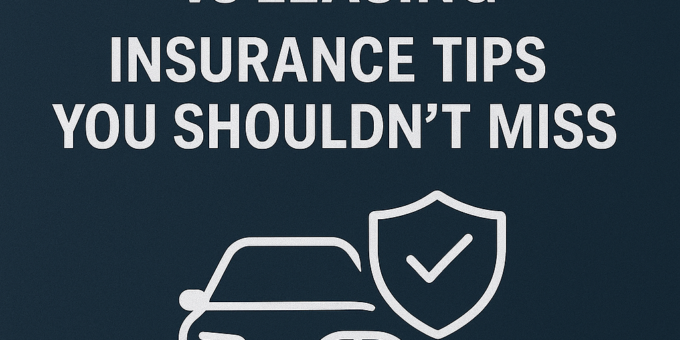
Introduction
Thinking about getting a new car? You’re probably asking yourself one of the biggest questions: Should I lease or finance? But here’s the twist—your decision impacts more than just your monthly payment. It also changes what you’ll pay for car insurance and what kind of coverage you’ll need. Let’s break down the key differences so you don’t get stuck with surprise fees or the wrong insurance plan.
Understanding Car Financing
What It Means to Finance a Car
When you finance a car, you’re taking out a loan to eventually own the vehicle outright. Monthly payments go toward both principal and interest.
Ownership and Loan Terms
You hold the car title after paying off the loan. Loan terms usually range from 36 to 72 months.
Insurance Requirements for Financed Vehicles
Lenders typically require:
-
Comprehensive and collision coverage
-
Liability coverage
-
Gap insurance is often optional—but recommended
Understanding Car Leasing
How Leasing Works
With a lease, you’re basically renting a car long-term—usually 2 to 4 years. You return it when the lease ends.
Mileage Limits and Wear & Tear
Leases come with annual mileage caps (e.g., 12,000 miles/year) and fees for excessive wear and tear.
Insurance Rules When Leasing a Vehicle
Lessors require:
-
High liability limits (often $100,000/$300,000)
-
Collision and comprehensive with low deductibles
-
Gap insurance (usually mandatory)
Key Insurance Differences Between Financing and Leasing
Collision & Comprehensive Coverage
Both leasing and financing require these coverages, but lease agreements often have stricter rules on deductible amounts.
Gap Insurance: Mandatory vs Optional
-
Leasing: Almost always mandatory
-
Financing: Optional, but smart if you owe more than the car’s value
Lender vs Lessor Requirements
Lessors tend to be stricter. They want to protect their asset because they still own the car during the lease.
Pros and Cons of Insurance for Financed Cars
Flexibility in Coverage
You usually have more wiggle room with deductibles and policy choices.
Cost Implications
Insurance costs may be slightly lower compared to leases if you choose higher deductibles.
Resale and Modifications
You can customize your car, which can influence coverage. Plus, resale value plays into your total cost.
Pros and Cons of Insurance for Leased Cars
Higher Minimum Coverage
Leases often require more insurance, making monthly premiums higher.
Less Customization Allowed
No big modifications. After all, you’re just borrowing the car.
Cost Considerations and Hidden Fees
Lessors may include insurance surcharges or penalize you for minor coverage lapses.
Gap Insurance Explained
What Is Gap Insurance?
Gap insurance covers the difference between what your car is worth and what you owe if it’s totaled or stolen.
Why It’s Crucial for Leasing
Since you don’t own the car, you can still owe thousands even after insurance pays out.
Where to Buy It
-
From the dealership: Usually more expensive
-
From your insurer: Often cheaper and flexible
What Lenders Require vs What Lessors Require
Minimum Liability
-
Lenders: State minimum or slightly higher
-
Lessors: Typically $100k/$300k minimum
Deductible Limits
Some lessors cap deductibles at $500 or $1,000 to ensure quick repairs.
Proof of Insurance
Both require proof before delivery, but lease contracts may demand faster updates for policy changes.
Insurance Costs: Leasing vs Financing
Leased Cars Cost More to Insure
Due to higher liability limits and lower deductible requirements, leased vehicles often cost more to insure monthly.
Financed Cars Offer More Flexibility
You can raise deductibles or reduce coverage (if your loan allows it) to cut costs.
What Insurers Consider
-
Your credit score
-
Where you live
-
How far you drive annually
How to Save on Insurance Whether You Lease or Finance
Bundle with Other Policies
Home + auto = multi-policy discount.
Raise Your Deductible
If your budget allows, choosing a $1,000 deductible can save you 10–25%.
Shop Around Regularly
Use comparison tools like:
-
The Zebra
-
Policygenius
-
Compare.com
Choosing the Right Option Based on Insurance Needs
Lifestyle Fit
Drive a lot? Financing might be better. Just commuting a few miles daily? Leasing could work.
Risk Tolerance
Worried about damage or dents? You may want the flexibility of ownership.
Long-Term vs Short-Term Costs
Leasing can be cheaper short term, but financing gives you equity over time.
Common Insurance Mistakes to Avoid
Skipping Gap Insurance
Don’t risk owing money on a totaled car.
Minimum Coverage Only
Low coverage = high risk. One accident could bankrupt you.
Not Updating Mileage
Incorrect mileage data can invalidate claims or jack up rates.
Expert Tips from Insurance Advisors
Advice for First-Time Buyers
-
Always compare quotes
-
Understand what coverage you’re buying
-
Don’t buy extras you don’t need at the dealership
Adjusting Coverage Mid-Term
Got a better job? Moved to a safer area? Re-shop your policy.
Avoiding Dealership Upsells
Buy your insurance and gap policy separately when possible. It’s usually cheaper.
Conclusion
Whether you lease or finance, car insurance isn’t one-size-fits-all. The smartest move? Know what each option demands, what it’ll cost you, and where you can save. With a bit of planning and the right tools, you can avoid costly insurance traps—and cruise with confidence.